Blue Ridge Rocks: the microscopic view
The Alberene Dream Team spent the summer of 2011 in the field working to understand the geology of the eastern Blue Ridge. As summer turned into the fall semester, the team compiled their data and started to analyze the buckets of rocks we’d collected during the field campaign. In the Geology Department we cut rocks into small chips that were then glued to a glass slide, sawed once again, and finally ground down until the thickness of the rock is ~30 micrometers. For obvious reasons these microscope slides are called thin sections. Light typically passes through the thin sliver of rock and under the microscope the mineralogy and texture of the sample are revealed in a beautiful and colorful fashion. What follows is a report from each member of the Dream Team on the microscopic character of some eastern Blue Ridge rocks and what can be gleaned from thin section observations.
Alex Johnson- Yes, it is very Gneiss, just don’t take it for Granite
It was a strange twist of fate that I, the youngest member of the dream team, chose a thin section of the oldest rock unit in the study region—the Blue Ridge basement complex. The rock originally crystallized as a granite some one billion years ago. Large feldspar phenocrysts bear witness to the rock’s igneous heritage. But, a billion years is a long time and geologic hijinks happens—this rock is best described as a biotite-bearing granitoid gneiss. Biotite, muscovite, epidote, and sphene form a posse of metamorphic minerals that overprint the original texture. Quartz, an original igneous mineral, has recrystallized into strain-free aggregates with tidy and straight grain boundaries. Alas, the poor feldspars. To call them disturbed would be too kind, destroyed too cruel, but somewhere in between it lies. The feldspars have been saussuritized, hydrothermally altered to a fine-grained mixture of epidote, sericite, and zoisite. That’s what a billion years and a couple of orogenic events gets you.
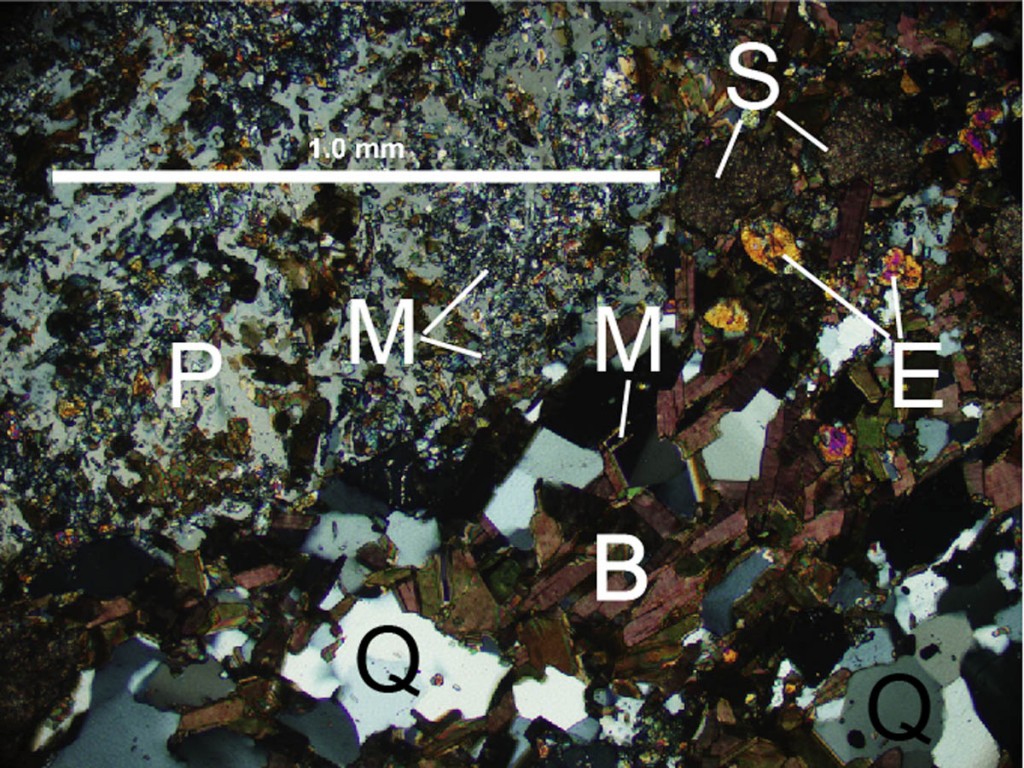
Micrograph of biotite-bearing granitoid gneiss from the Blue Ridge basement complex. Large saussuritized feldspar in upper left. Note metamorphic minerals such as biotite (B), epidote (E), muscovite (M), quartz (Q) and sphene (S). Cross polarized light.
Andrea Jensen- Soaking up the soapstone
Ultramafic rocks are characterized by very low silica content and are dominated by dark colored minerals with plentiful iron and magnesium. They are igneous rocks associated with magmas derived from the mantle deep within the Earth. The Alberene quadrangle is bursting with ultramafic rocks that were originally pyroxenites dominated by the mineral pyroxene with lesser amounts of olivine and plagioclase feldspar. These pyroxenites have since undergone low grade metamorphism and been transformed into carbonate-bearing soapstones. The soapstone in the Alberene area is so extensive that it has long been quarried—native peoples used this soft stone for heat resistant bowls and pipes; modern uses include chemically resistant counter tops, architectural flagstone, and as a medium for sculpture.
Controversy surrounds the origin of the ultramafic rocks in the eastern Blue Ridge. Some workers suggest these are differentiated mantle-derived magmas that intruded thinned continental crust during rifting, whereas other geologists posit that these rocks are altered bits of the mantle thrust into place during tectonic collision. Regardless of how they formed, these rocks have since enjoyed metamorphism. Soft minerals such as chlorite, talc and carbonate replaced original minerals.
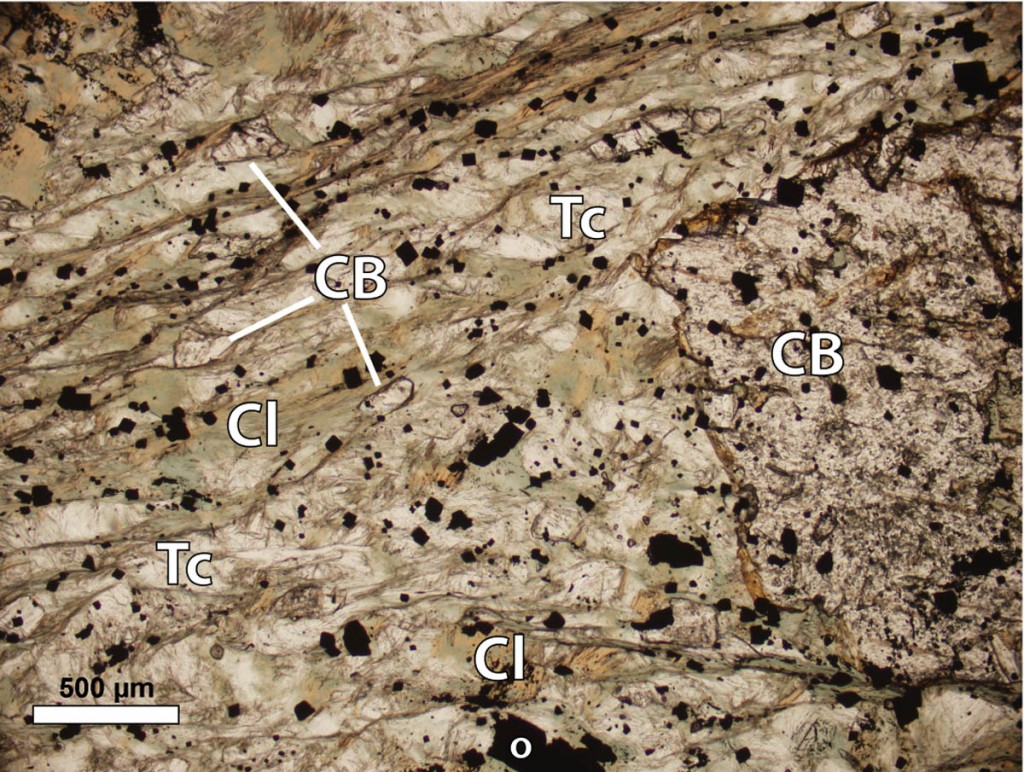
Micrograph of altered ultramafic rock (soapstone) with talc (Tc) and chlorite (Cl), carbonate (CB) and opaque minerals (o). Plane polarized light.
Molly Hahn- A dark and dirty rock
The graphitic schist illustrated below forms layers within metasedimentary rocks of the Lynchburg Group. In hand sample it is a fine-grained black rock with well-developed foliation and rusty patches. In thin section, the majority of the rock is dark and opaque with bands of gray, elongated quartz grains and reddish brown biotite grains. The banding and elongation of minerals is called foliation—the result of mineral recrystallization and realignment during deformation. The dark materials are a mixture of graphite, a soft fine-grained platy mineral composed entirely of carbon, and iron oxide minerals. Just what is the source of carbon in this rock? One possible source is organic matter, perhaps the remains of microscopic organisms, that was deposited as seafloor mud in a dank anoxic environment. The Lynchburg Group is a thick sequence of mostly marine rocks deposited during the Neoproterozoic (~700 million years ago) long before complex shelled organisms had evolved. As the rock was buried and later metamorphosed the volatile elements in the organic matter were expelled and the carbon crystallized into graphite. The fine-grained iron oxide minerals likely came from oxidation of pyrite (iron-sulfide) during metamorphism and/or later weathering near the Earth’s surface.
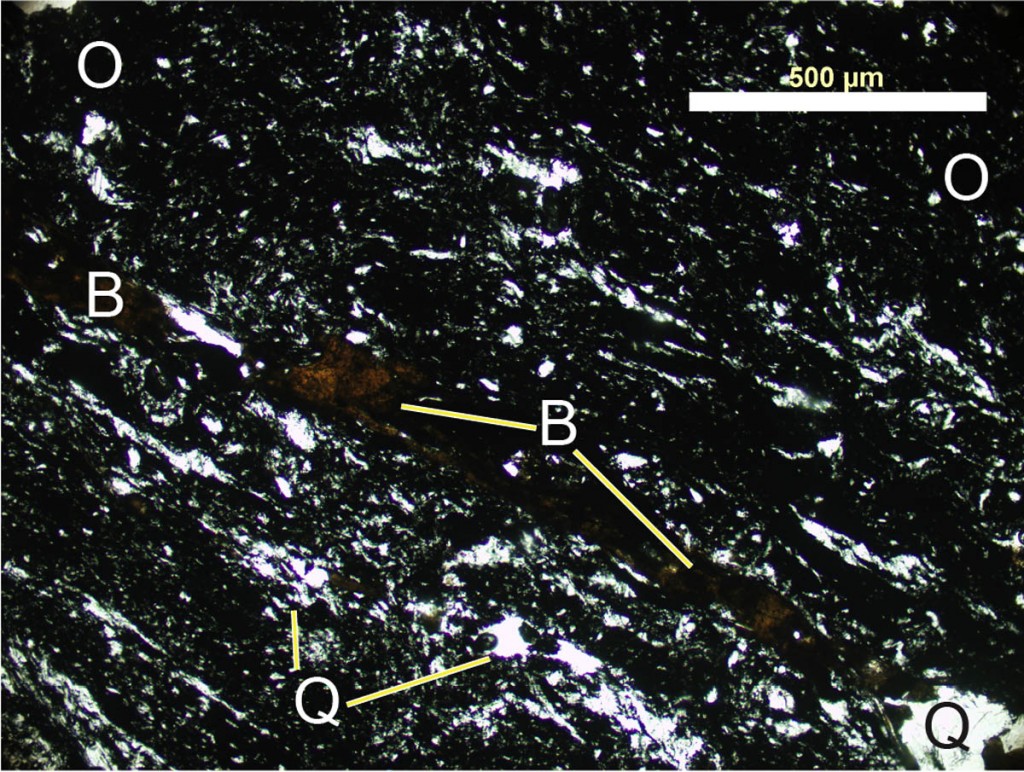
Micrograph of graphitic schist with fine-grained opaque minerals (O), quartz (Q), and biotite (B) and well-developed foliation (the alignment of minerals from the upper left to lower right). Plane polarized light.
Kevin Quinlan- Mistaken identity
The Scottsville Basin, located a few kilometers south of the Alberene quadrangle, is a body of sedimentary rocks that formed during the breakup of Pangaea some 200 million years ago. My research focuses on describing how the rocks in the basin have deformed over time. This sample came from a low outcrop in the James River and contains abundant quartz and plagioclase feldspar. These mineral grains are rounded, evidence that they were deposited as detrital sediments. Individual grains are held together by a fine-grained matrix, giving the rock a clastic texture. This texture is a good indication that the sample began as a sedimentary rock, probably sandstone. Notice, however, that the matrix between grains is dominated by brightly colored, elongate crystals. This is the mineral muscovite, formed when clay minerals in mud are heated to at least 350 °C at pressures that occur 10 to 20 kilometers below the Earth’s surface. Under these conditions the rock experiences metamorphism. Hence, the rock is best described as metamorphosed sandstone. Metamorphism in the Piedmont happened during the late Paleozoic (~300 million years ago). The Scottsville Basin formed after Paleozoic metamorphism. However, existing geologic maps place this meta-sandstone within the basin. Because we know that this rock is too old to be part of the basin, it’s reasonable to assume that the boundary of the basin has been improperly drawn on old maps. This finding will help me in my research goal of more accurately delineating the basin’s borders.
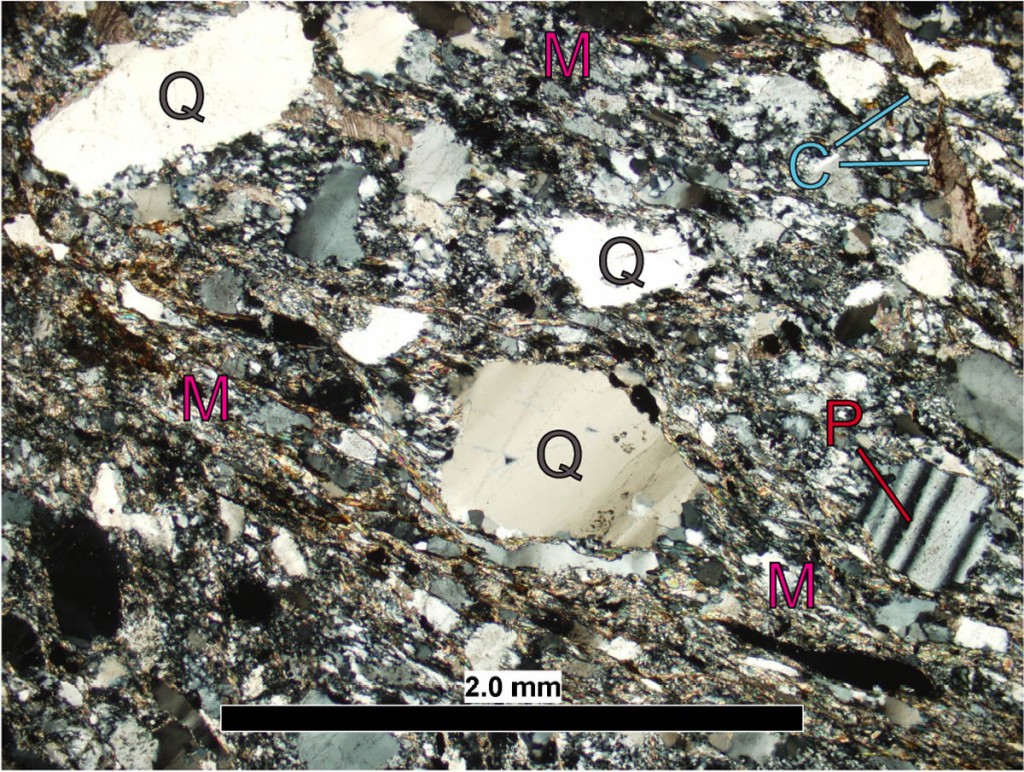
Micrograph of micaceous meta-sandstone from the James River. Clasts of quartz (Q) and plagioclase (P) in matrix (M) of fine-grained muscovite and quartz. Calcite vein (C) cuts sample. Cross polarized light.
Chuck Bailey- The Monticello mystery
One of our research targets is an intriguing rock reported to crop out in the vicinity of Thomas Jefferson’s Monticello. A number of older geologic studies describe an alaskite, a felsic igneous rock composed primarily of K-feldspar (K for the element potassium) and quartz, intruding the greenstones of the Catoctin Formation. Alaskite, as a rock name, is anachronistic and modern petrologists refer to these rocks as alkali-granites. We located a string of linear outcrops of a fine-grained feldspar rich rock to the south of Monticello. The microscopic view reveals the rock is loaded with K-feldspar with lesser amounts of quartz, opaque minerals, and plagioclase. But it is the texture of the rock that tells the important story—this rock has a clastic texture, composed of rounded to angular fragments of sand grains in contact with one another. Clastic textures are diagnostic of sedimentary rocks. The Monticello ‘alaskite’ is a sedimentary rock, not an igneous rock as previously reported, that forms a layer within the sequence of Catoctin Formation lava flows. The source of this clast-supported arkosic arenite, the proper name for this rock, is a mystery as the K-feldspar could not be derived from the mafic Catoctin Formation. The older granitic basement complex, exposed to the west of the Catoctin Formation, does contain some K-feldspar, but what processes would concentrate the K-feldspar to such a degree? That’s the nature of research—as one question gets answered, others arise.
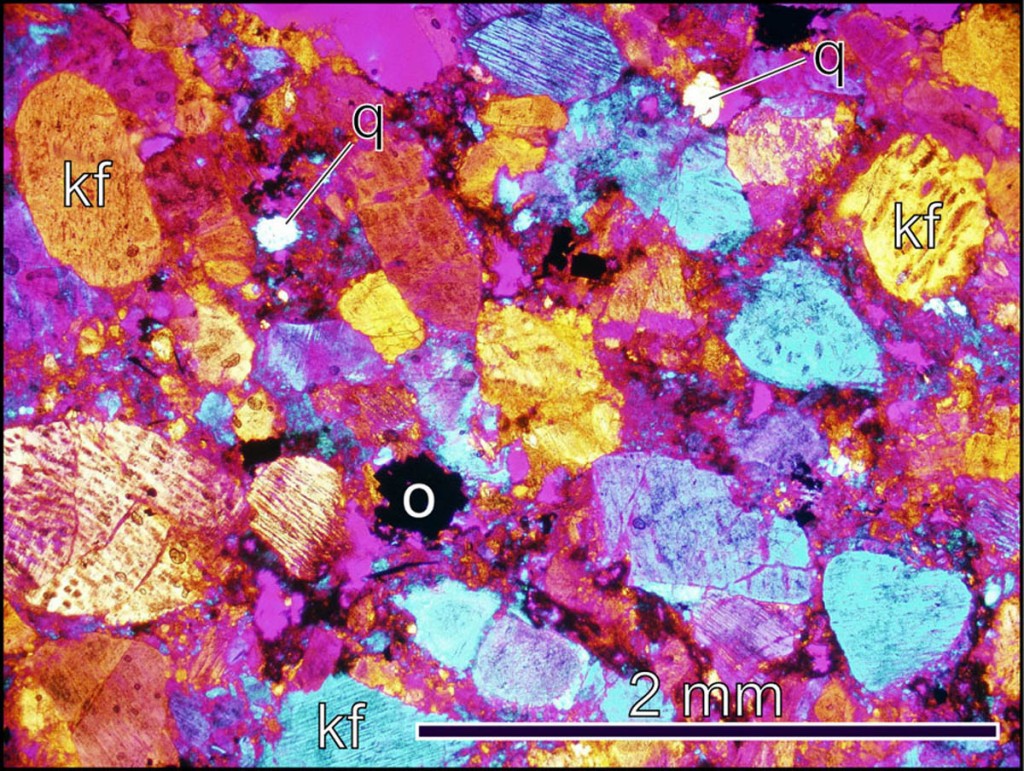
Micrograph of arkosic arenite from near Monticello. Note well-developed clastic texture with rounded to subangular clasts. kf- K-feldspar, q- quartz, o- opaque minerals. Cross polarized light with interference plate.
Comments are currently closed. Comments are closed on all posts older than one year, and for those in our archive.

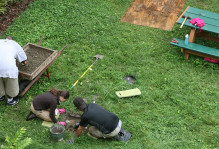

Something strange going on with all of the K-spar in the Blue Ridge during the Neoproterozoic. Swift Run is loaded with it, you’ve got K-feldspar veins in the basement shear zones, and now this! Maybe an extreme quartz dissolution event during upper greenschist facies metamorphism?